Peugeot Boxer 2016 Owner's Manual
Manufacturer: PEUGEOT, Model Year: 2016, Model line: Boxer, Model: Peugeot Boxer 2016Pages: 292, PDF Size: 10.07 MB
Page 131 of 292
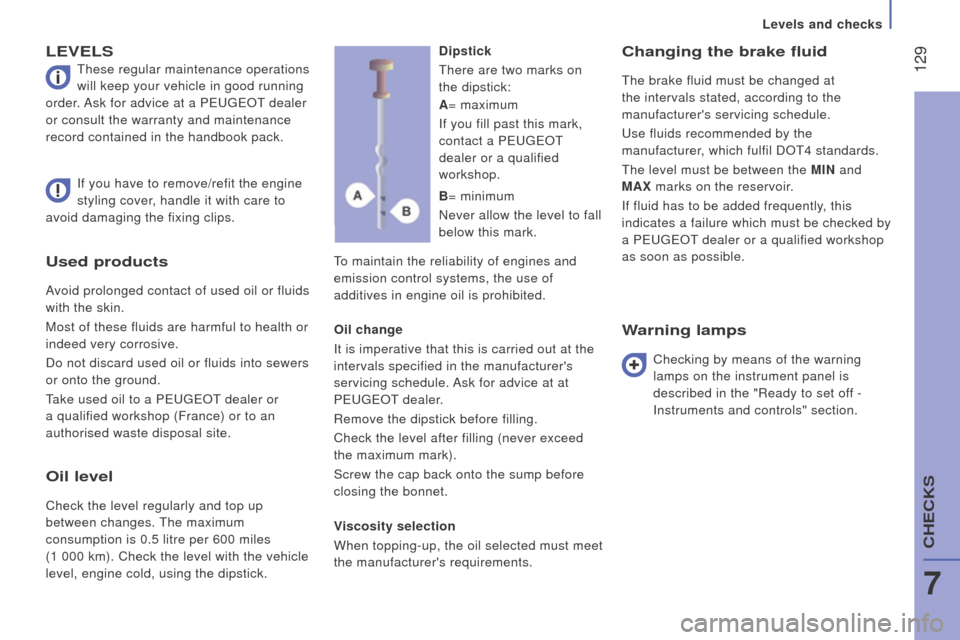
129
boxer_en_Chap07_Verifications_ed01-2015
used products
Avoid prolonged contact of used oil or fluids
with the skin.
Most of these fluids are harmful to health or
indeed very corrosive.
Do not discard used oil or fluids into sewers
or onto the ground.
take used oil to a P
euge O t
dealer or
a qualified workshop (France) or to an
authorised waste disposal site.
LEVELS
these regular maintenance operations
will keep your vehicle in good running
order. Ask for advice at a P
euge O t
dealer
or consult the warranty and maintenance
record contained in the handbook pack.
to maintain the reliability of engines and
emission control systems, the use of
additives in engine oil is prohibited.
changing the brake fluid
the brake fluid must be changed at
the intervals stated, according to the
manufacturer's servicing schedule.
u
se fluids recommended by the
manufacturer, which fulfil DO
t 4 standards.
t
he level must be between the MI n and
MA
x marks on the reservoir.
If fluid has to be added frequently, this
indicates a failure which must be checked by
a P
euge O t
dealer or a qualified workshop
as soon as possible.
If you have to remove/refit the engine
styling cover, handle it with care to
avoid damaging the fixing clips.
d
ipstickt
here are two marks on
the dipstick:
o
il change
It is imperative that this is carried out at the
intervals specified in the manufacturer's
servicing schedule. Ask for advice at at
P
euge
O
t
dealer
.
Remove the dipstick before filling.
Check the level after filling (never exceed
the maximum mark).
Screw the cap back onto the sump before
closing the bonnet.
Viscosity selection
When topping-up, the oil selected must meet
the manufacturer's requirements.
Warning lamps
Checking by means of the warning
lamps on the instrument panel is
described in the "Ready to set off -
Instruments and controls" section.
A
= maximum
If you fill past this mark,
contact a P
euge
O
t
dealer or a qualified
workshop.
B = minimum
Never allow the level to fall
below this mark.
oil level
Check the level regularly and top up
between changes.
t
he maximum
consumption is 0.5 litre per 600 miles
(1 000
km). Check the level with the vehicle
level, engine cold, using the dipstick.
Levels and checks
7
CHeCKS
Page 132 of 292
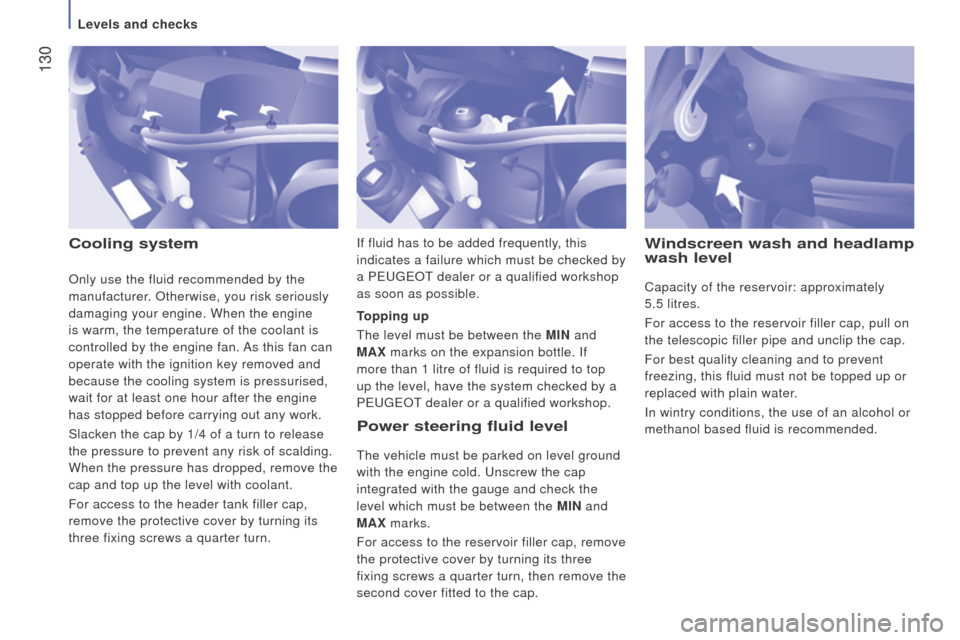
130
boxer_en_Chap07_Verifications_ed01-2015
cooling systemPower steering fluid level
the vehicle must be parked on level ground
with the engine cold. u nscrew the cap
integrated with the gauge and check the
level which must be between the MI
n and
MA
x marks.
For access to the reservoir filler cap, remove
the protective cover by turning its three
fixing screws a quarter turn, then remove the
second cover fitted to the cap.
topping up
t
he level must be between the MI n and
MA x marks on the expansion bottle. If
more than 1 litre of fluid is required to top
up the level, have the system checked by a
P euge O t
dealer or a qualified workshop.
Windscreen wash and headlamp
wash level
Capacity of the reservoir: approximately
5.5
litres.
For access to the reservoir filler cap, pull on
the telescopic filler pipe and unclip the cap.
For best quality cleaning and to prevent
freezing, this fluid must not be topped up or
replaced with plain water.
In wintry conditions, the use of an alcohol or
methanol based fluid is recommended.
If fluid has to be added frequently, this
indicates a failure which must be checked by
a P
euge
O
t dealer or a qualified workshop
as soon as possible.
Only use the fluid recommended by the
manufacturer. Otherwise, you risk seriously
damaging your engine. When the engine
is warm, the temperature of the coolant is
controlled by the engine fan. As this fan can
operate with the ignition key removed and
because the cooling system is pressurised,
wait for at least one hour after the engine
has stopped before carrying out any work.
Slacken the cap by 1/4 of a turn to release
the pressure to prevent any risk of scalding.
When the pressure has dropped, remove the
cap and top up the level with coolant.
For access to the header tank filler cap,
remove the protective cover by turning its
three fixing screws a quarter turn.
Levels and checks
Page 133 of 292
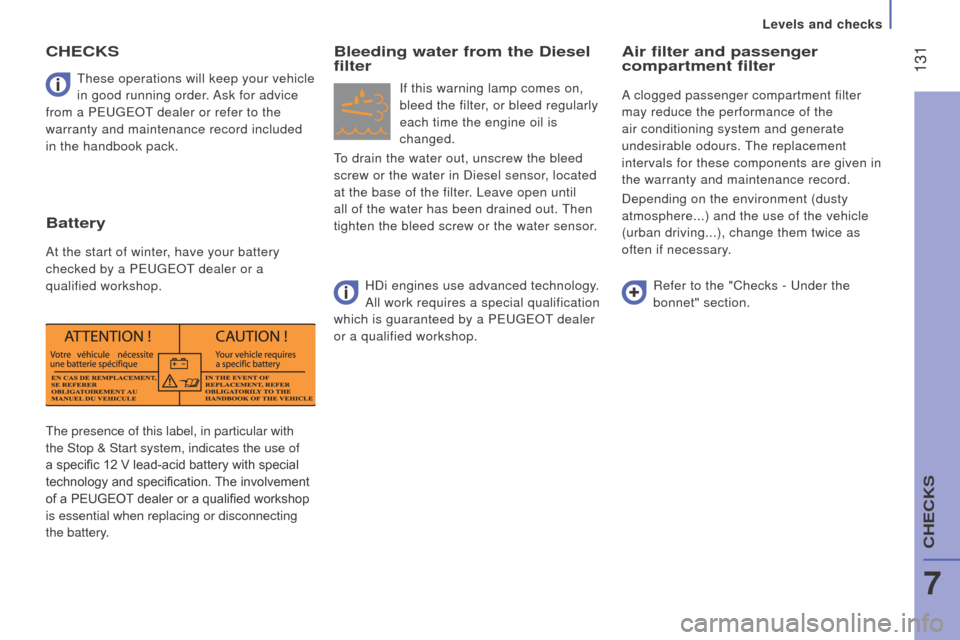
131
boxer_en_Chap07_Verifications_ed01-2015
the presence of this label, in particular with
the Stop & Start system, indicates the use of
a specific 12
V lead-acid battery with special
technology and specification. The involvement
of a PEUGEOT dealer or a qualified workshop
is essential when replacing or disconnecting
the battery.
t
hese operations will keep your vehicle
in good running order. Ask for advice
from a P euge O t
dealer or refer to the
warranty and maintenance record included
in the handbook pack.
cHEcKS
Battery
At the start of winter, have your battery
checked by a P euge O t
dealer or a
qualified workshop.
Bleeding water from the diesel
filter
If this warning lamp comes on,
bleed the filter, or bleed regularly
each time the engine oil is
changed.
to drain the water out, unscrew the bleed
screw or the water in Diesel sensor, located
at the base of the filter. Leave open until
all of the water has been drained out.
t
hen
tighten the bleed screw or the water sensor.
Air filter and passenger
compartment filter
A clogged passenger compartment filter
may reduce the performance of the
air conditioning system and generate
undesirable odours.
t
he replacement
intervals for these components are given in
the warranty and maintenance record.
Depending on the environment (dusty
atmosphere...) and the use of the vehicle
(urban driving...), change them twice as
often if necessary.
Refer to the "Checks -
u nder the
bonnet" section.
HDi engines use advanced technology.
All work requires a special qualification
which is guaranteed by a P
euge
O
t
dealer
or a qualified workshop.
Levels and checks
7
CHeCKS
Page 134 of 292
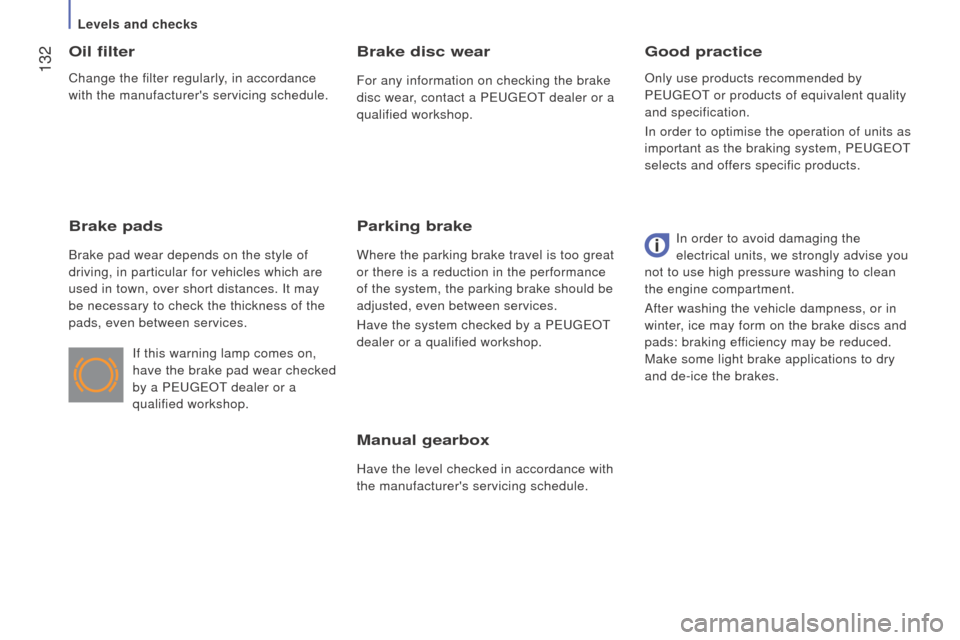
132
boxer_en_Chap07_Verifications_ed01-2015
Manual gearbox
Have the level checked in accordance with
the manufacturer's servicing schedule.
Good practiceo
il filter
Brake pads
Brake pad wear depends on the style of
driving, in particular for vehicles which are
used in town, over short distances. It may
be necessary to check the thickness of the
pads, even between services.
Brake disc wear
For any information on checking the brake
disc wear, contact a P euge O t
dealer or a
qualified workshop.
Parking brake
Where the parking brake travel is too great
or there is a reduction in the performance
of the system, the parking brake should be
adjusted, even between services.
Have the system checked by a P
euge O t
dealer or a qualified workshop.
If this warning lamp comes on,
have the brake pad wear checked
by a P
euge
O
t
dealer or a
qualified workshop. In order to avoid damaging the
electrical units, we strongly advise you
not to use high pressure washing to clean
the engine compartment.
After washing the vehicle dampness, or in
winter, ice may form on the brake discs and
pads: braking efficiency may be reduced.
Make some light brake applications to dry
and de-ice the brakes. Only use products recommended by
P euge O t
or products of equivalent quality
and specification.
In order to optimise the operation of units as
important as the braking system, P euge O t
selects and of
fers specific products.
Change the filter regularly, in accordance
with the manufacturer's servicing schedule.
Levels and checks
Page 135 of 292
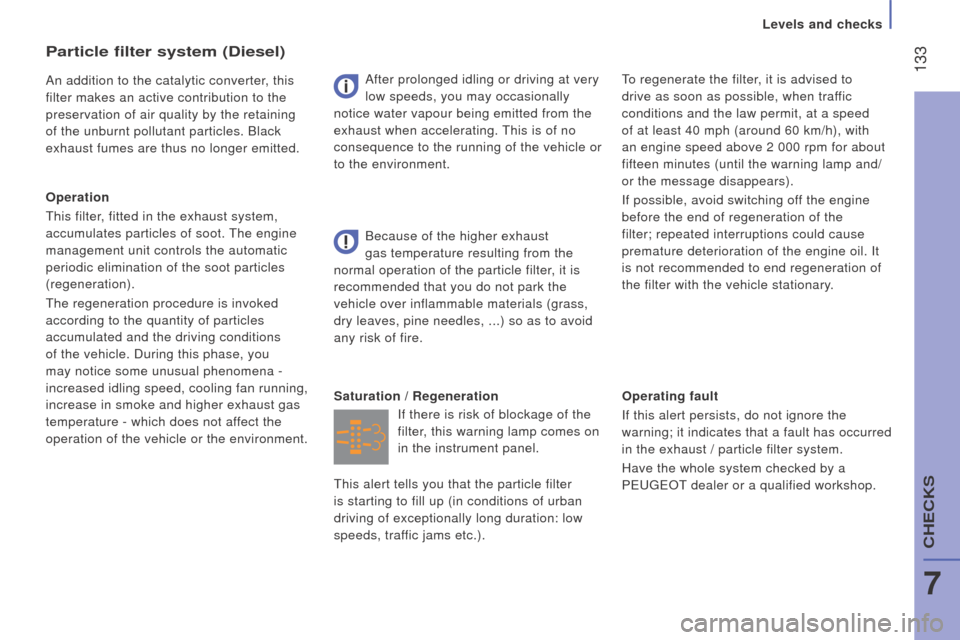
133
boxer_en_Chap07_Verifications_ed01-2015
operating fault
If this alert persists, do not ignore the
warning; it indicates that a fault has occurred
in the exhaust / particle filter system.
Have the whole system checked by a
P
euge O t
dealer or a qualified workshop.
If there is risk of blockage of the
filter, this warning lamp comes on
in the instrument panel.
Saturation /
r
egeneration
Because of the higher exhaust
gas temperature resulting from the
normal operation of the particle filter, it is
recommended that you do not park the
vehicle over inflammable materials (grass,
dry leaves, pine needles,
...) so as to avoid
any risk of fire.
Particle filter system (diesel)
An addition to the catalytic converter, this
filter makes an active contribution to the
preservation of air quality by the retaining
of the unburnt pollutant particles. Black
exhaust fumes are thus no longer emitted.
o
peration
t
his filter, fitted in the exhaust system,
accumulates particles of soot.
t
he engine
management unit controls the automatic
periodic elimination of the soot particles
(regeneration).
t
he regeneration procedure is invoked
according to the quantity of particles
accumulated and the driving conditions
of the vehicle. During this phase, you
may notice some unusual phenomena
-
increased idling speed, cooling fan running,
increase in smoke and higher exhaust gas
temperature
- which does not affect the
operation of the vehicle or the environment. After prolonged idling or driving at very
low speeds, you may occasionally
notice water vapour being emitted from the
exhaust when accelerating.
t
his is of no
consequence to the running of the vehicle or
to the environment.to regenerate the filter , it is advised to
drive as soon as possible, when traffic
conditions and the law permit, at a speed
of at least 40
mph (around 60 km/h), with
an engine speed above 2 000 rpm for about
fifteen
minutes (until the warning lamp and/
or the message disappears).
If possible, avoid switching off the engine
before the end of regeneration of the
filter; repeated interruptions could cause
premature deterioration of the engine oil. It
is not recommended to end regeneration of
the filter with the vehicle stationary.
t
his alert tells you that the particle filter
is starting to fill up (in conditions of urban
driving of exceptionally long duration: low
speeds, traffic jams etc.).
Levels and checks
7
CHeCKS
Page 136 of 292
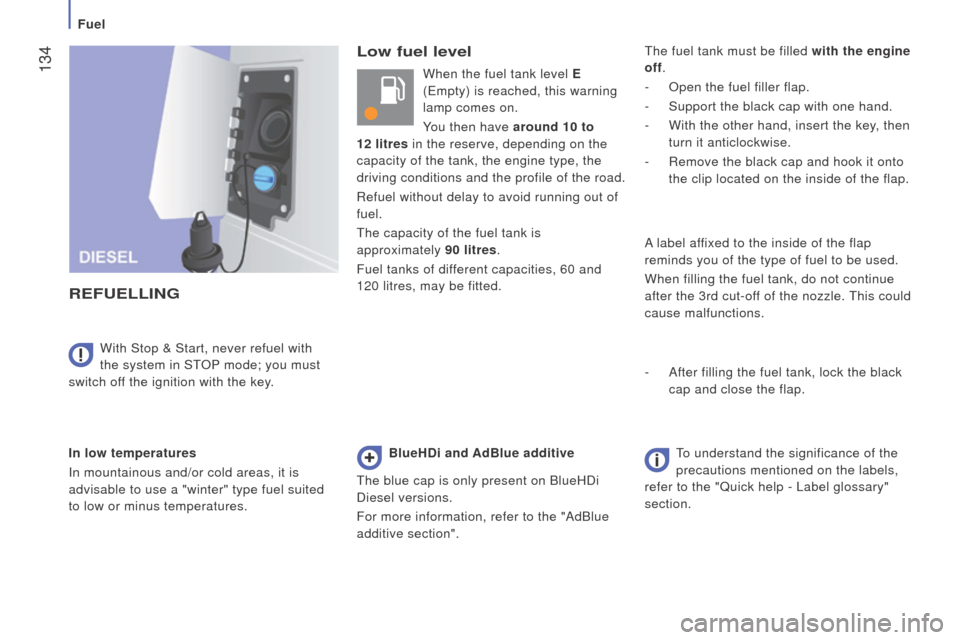
134
boxer_en_Chap07_Verifications_ed01-2015
Low fuel level
rEF
u
ELLI
n
G
In low temperatures
In mountainous and/or cold areas, it is
advisable to use a "winter" type fuel suited
to low or minus temperatures. With Stop & Start, never refuel with
the system in S
t
OP
mode; you must
switch off the ignition with the key. When the fuel tank level E
( e mpty) is reached, this warning
lamp comes on.
You then have around 10 to
12 litres in the reserve, depending on the
capacity of the tank, the engine type, the
driving conditions and the profile of the road.
Refuel without delay to avoid running out of
fuel.
t
he capacity of the fuel tank is
approximately 90 litres.
Fuel tanks of different capacities, 60 and
120 litres, may be fitted.
t
he fuel tank must be filled with the engine
off.
-
Open the fuel filler flap.
-
Support the black cap with one hand.
-
With the other hand, insert the key
, then
turn it anticlockwise.
-
Remove the black cap and hook it onto
the clip located on the inside of the flap.
A label affixed to the inside of the flap
reminds you of the type of fuel to be used.
When filling the fuel tank, do not continue
after the 3rd cut-off of the nozzle.
t
his could
cause malfunctions.
-
After filling the fuel tank, lock the black
cap and close the flap.
BlueH d i and AdBlue additive
t
he blue cap is only present on BlueHDi
Diesel versions.
For more information, refer to the "AdBlue
additive section".to understand the significance of the
precautions mentioned on the labels,
refer to the "Quick help - Label glossary"
section.
Fuel
Page 137 of 292
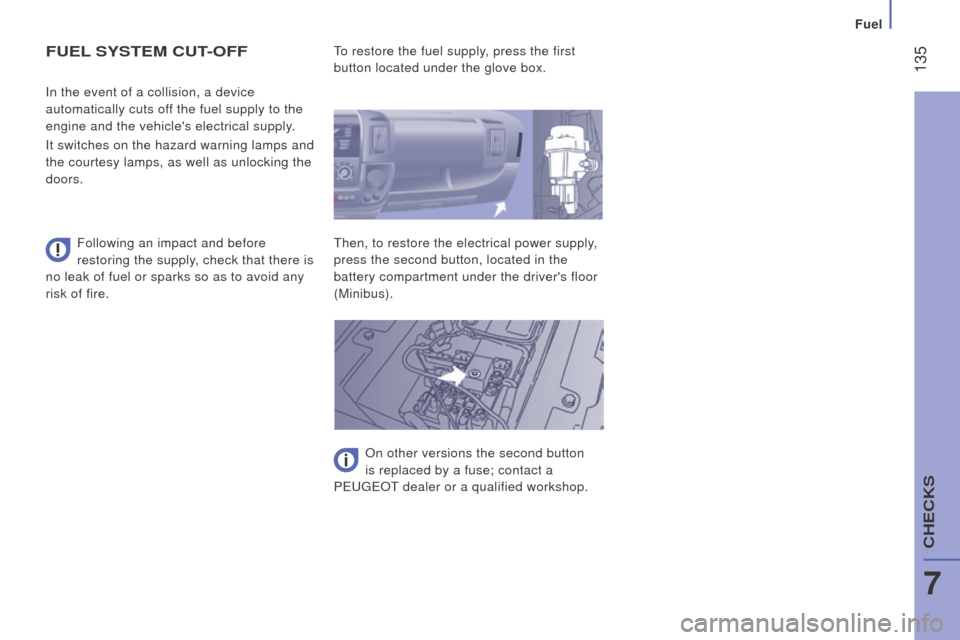
135
boxer_en_Chap07_Verifications_ed01-2015
FuEL SYS t EM cut-o FF
Following an impact and before
restoring the supply, check that there is
no leak of fuel or sparks so as to avoid any
risk of fire. In the event of a collision, a device
automatically cuts off the fuel supply to the
engine and the vehicle's electrical supply.
It switches on the hazard warning lamps and
the courtesy lamps, as well as unlocking the
doors.
to restore the fuel supply
, press the first
button located under the glove box.t hen, to restore the electrical power supply,
press the second button, located in the
battery compartment under the driver's floor
(Minibus).
On other versions the second button
is replaced by a fuse; contact a
P
euge O t
dealer or a qualified workshop.
Fuel
7
CHeCKS
Page 138 of 292
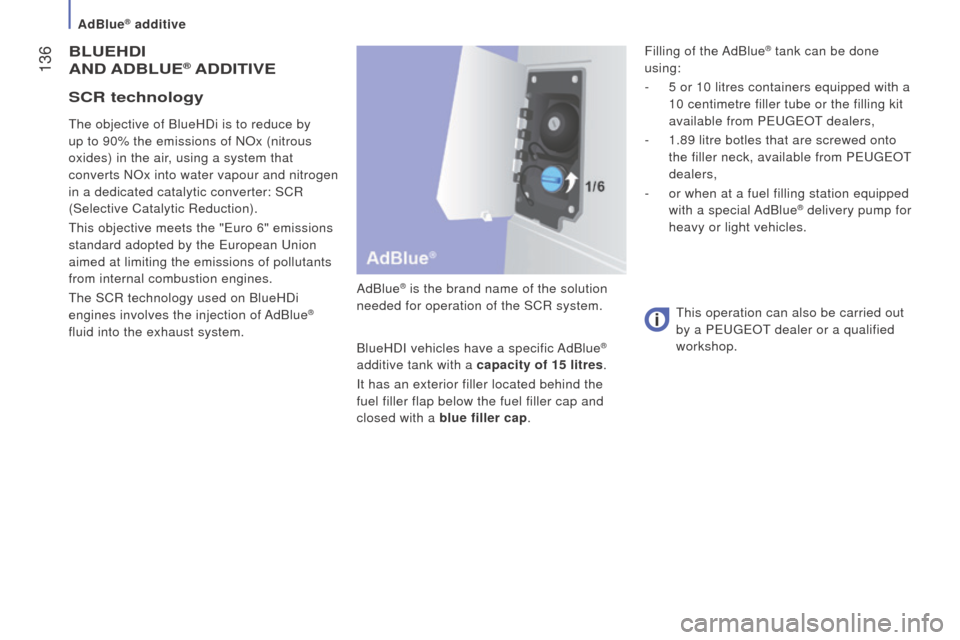
136
boxer_en_Chap07_Verifications_ed01-2015
BLuEHdI
A nd AdB L u E® AddItIVE
AdBlue® is the brand name of the solution
needed for operation of the SCR system.
BlueHDI vehicles have a specific AdBlue
®
additive tank with a capacity of 15 litres.
It has an exterior filler located behind the
fuel filler flap below the fuel filler cap and
closed with a blue filler cap.
t
he objective of BlueHDi is to reduce by
up to 90% the emissions of NOx (nitrous
oxides) in the air, using a system that
converts NOx into water vapour and nitrogen
in a dedicated catalytic converter: SCR
(Selective Catalytic Reduction).
t
his objective meets the "
e
uro 6" emissions
standard adopted by the
e
uropean
u
nion
aimed at limiting the emissions of pollutants
from internal combustion engines.
t
he SCR technology used on BlueHDi
engines involves the injection of AdBlue
®
fluid into the exhaust system.t his operation can also be carried out
by a P euge O t dealer or a qualified
workshop.
Scr technology
Filling of the AdBlue® tank can be done
using:
-
5 or 10 litres containers equipped with a
10 centimetre filler tube or the filling kit
available from P
euge O t
dealers,
-
1.89 litre botles that are screwed onto
the filler neck, available from P
euge O t
dealers,
-
or when at a fuel filling station equipped
with a special AdBlue
® delivery pump for
heavy or light vehicles.
AdBlue® additive
Page 139 of 292
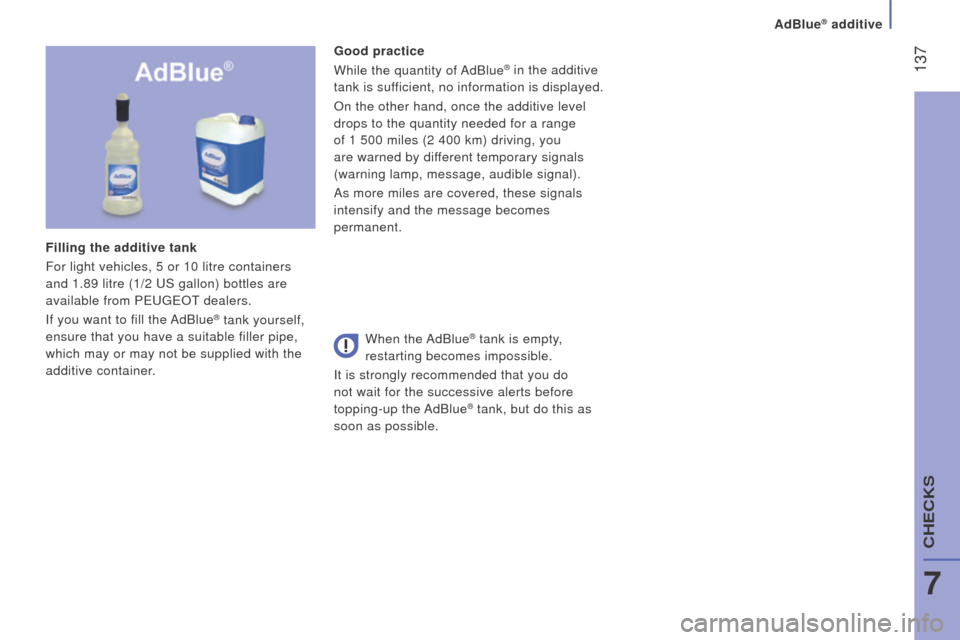
137
boxer_en_Chap07_Verifications_ed01-2015
Good practice
While the quantity of AdBlue® in the additive
tank
is sufficient, no information is displayed.
On the other hand, once the additive level
drops to the quantity needed for a range
of 1 500 miles (2 400 km) driving, you
are warned by different temporary signals
(warning lamp, message, audible signal).
As more miles are covered, these signals
intensify and the message becomes
permanent.
Filling the additive tank
For light vehicles, 5 or 10 litre containers
and 1.89 litre (1/2
u
S gallon) bottles are
available from P
euge
O
t
dealers.
If you want to fill the
AdBlue
® tank yourself,
ensure that you have a suitable filler pipe,
which may or may not be supplied with the
additive container. When the AdBlue® tank is empty,
restarting becomes impossible.
It is strongly recommended that you do
not wait for the successive alerts before
topping-up the AdBlue
® tank, but do this as
soon as possible.
AdBlue® additive
7
CHeCKS
Page 140 of 292
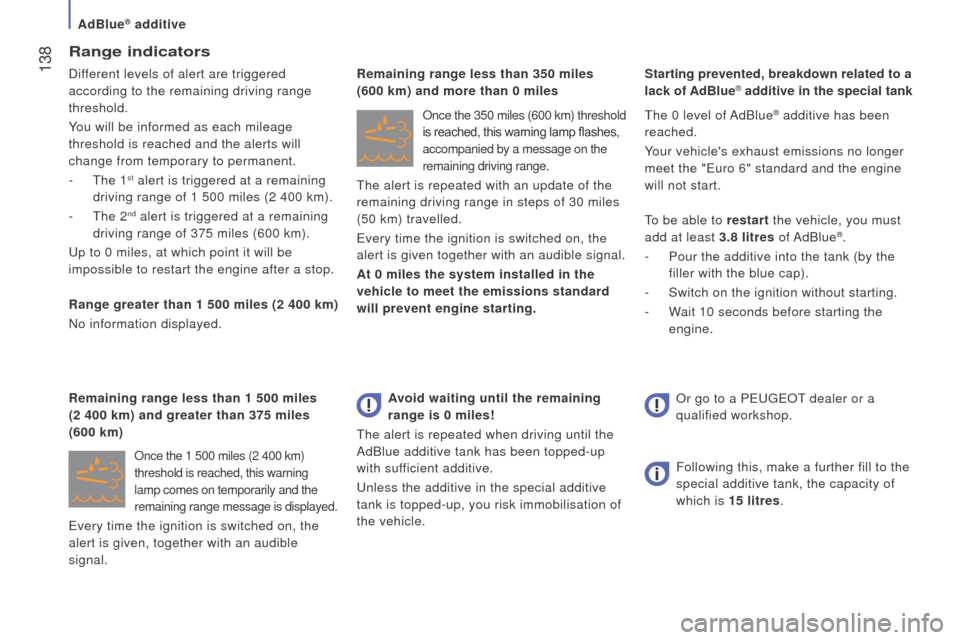
138
boxer_en_Chap07_Verifications_ed01-2015
range indicators
Different levels of alert are triggered
according to the remaining driving range
threshold.
You will be informed as each mileage
threshold is reached and the alerts will
change from temporary to permanent.
- t he 1
st alert is triggered at a remaining
driving range of 1 500 miles (2 400 km).
-
t
he 2
nd alert is triggered at a remaining
driving range of 375 miles (600 km).
u
p to 0 miles, at which point it will be
impossible to restart the engine after a stop.
r
ange greater than 1 500 miles (2 400 km)
No information displayed.
Once the 1 500 miles (2 400 km)
threshold is reached, this warning
lamp comes on temporarily and the
remaining range message is displayed.
every time the ignition is switched on, the
alert is given, together with an audible
signal.
r
emaining range less than 1 500 miles
(2 400 km) and greater than 375 miles
(600 km)
Once the 350 miles (600 km) threshold
is reached, this warning lamp flashes,
accompanied by a message on the
remaining driving range.
the alert is repeated with an update of the
remaining driving range in steps of 30 miles
(50 km) travelled.
e
very time the ignition is switched on, the
alert is given together with an audible signal.
At 0 miles the system installed in the
vehicle to meet the emissions standard
will prevent engine starting.
t
he 0 level of AdBlue
® additive has been
reached.
Your vehicle's exhaust emissions no longer
meet the "
e
uro 6" standard and the engine
will not start.
to be able to
restart the vehicle, you must
add at least 3.8 litres of AdBlue
®.
-
Pour the additive into the tank (by the
filler with the blue cap).
-
Switch on the ignition without starting.
-
W
ait 10 seconds before starting the
engine.
r
emaining range less than 350 miles
(600 km) and more than 0 miles Starting prevented, breakdown related to a
lack of AdBlue
®
additive in the special tank
Avoid waiting until the remaining
range is 0 miles!
t
he alert is repeated when driving until the
AdBlue additive tank has been topped-up
with sufficient additive.
u
nless the additive in the special additive
tank is topped-up, you risk immobilisation of
the vehicle. Following this, make a further fill to the
special additive tank, the capacity of
which is 15 litres. Or go to a P
euge O t
dealer or a
qualified workshop.
AdBlue® additive